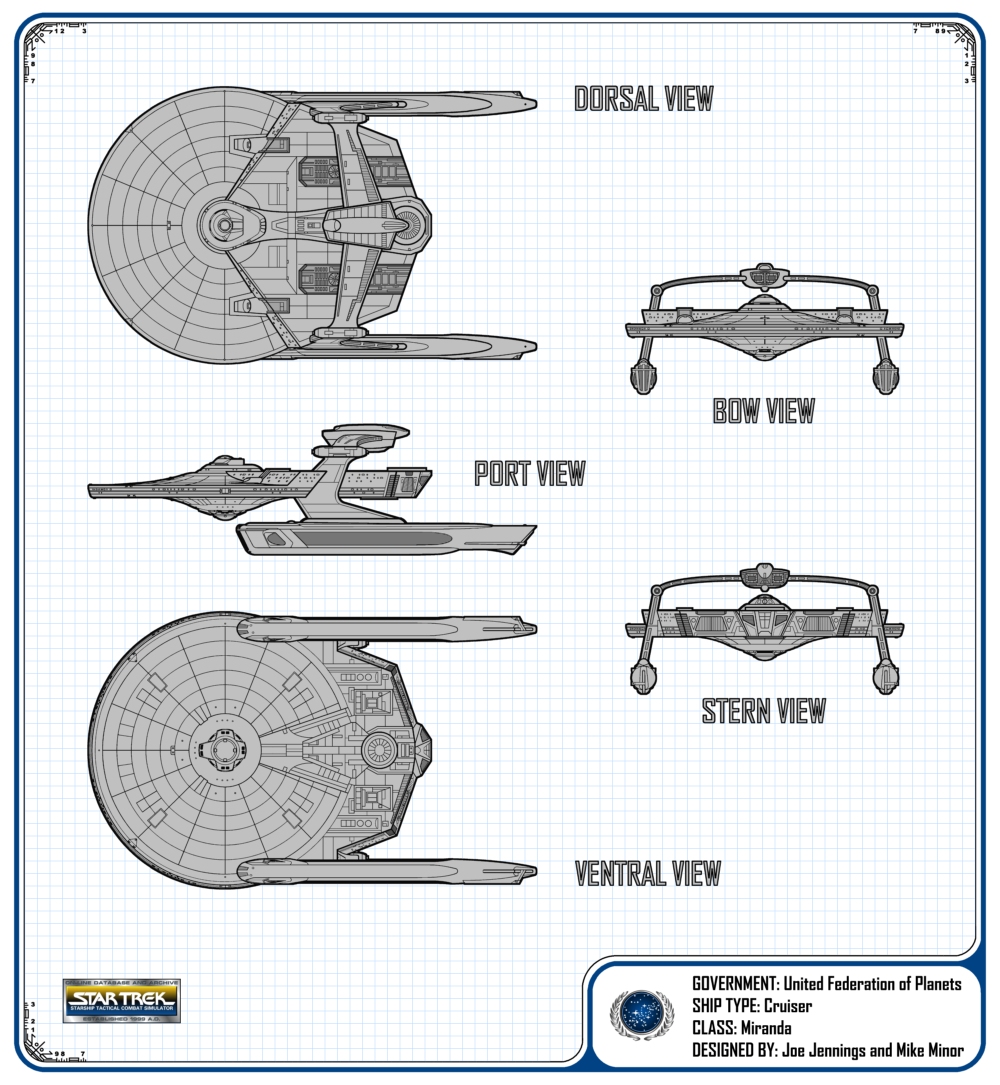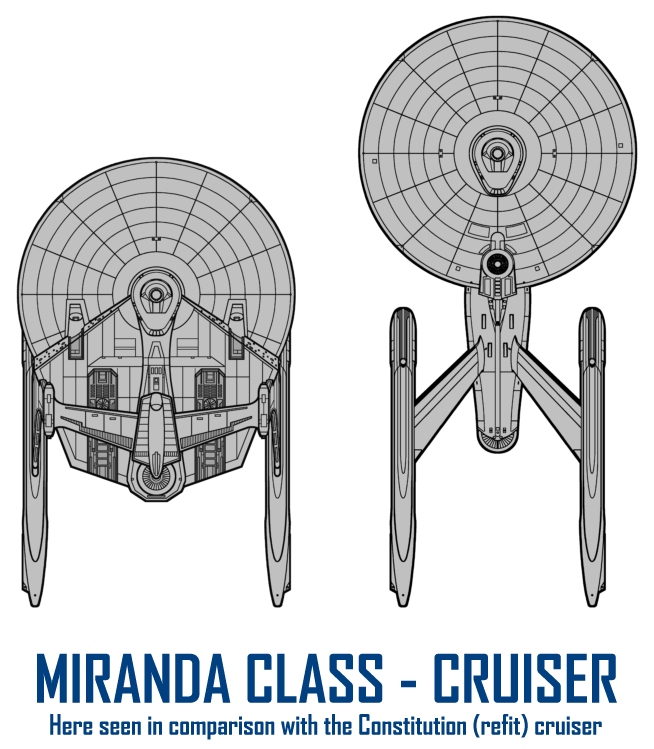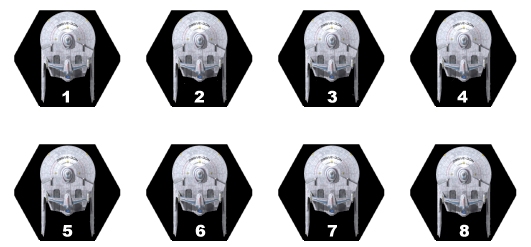![]()
Miranda Class ● Cruiser ● United Federation of Planets

CLICK ABOVE TO SEE A DOUBLE-SIZE BLUEPRINT
|
THIS IS MAYBE MY SECOND ALL-TIME MOST FAVORITE STAR TREK
SHIP DESIGN. But in official Trek canon there
is no such thing as the "Reliant class" which FASA weaves a story
around. We find out in ST:TNG that these ships
are known as the Miranda class, and we also see a mildly modified sub-class of
the Miranda, w/o the
'roll bar', called the Soyuz. Personally, I never liked the removal of the roll bar, especially since it made perfect sense that this is where the
all-important torpedo bay would be located—along with the two phaser banks that
fired forward/port and forward/starboard. — BRT
From the FASA Star Trek FEDERATION SHIP RECOGNITION MANUAL, circa 1985 |

| Construction Data: Model Numbers- Ship Class- Date Entering Service- Number Constructed |
MK I XI 2/1507 52 |
MK II XI 2/1802 46 |
MK III XI 2/2204 175 |
MK IV * X 2307 A.D. 183 |
MK V * XI 2314 A.D. 204 |
MK VI * XII 2329 A.D. 212 |
| Hull Data: Superstructure Points- Damage Chart- Size Length- Width- Height- Weight- Cargo Cargo Units- Cargo Capacity- Landing Capability- |
22 C 233 meters 140 meters 64 meters 165,800 tons 400 units 20,000 tons None |
24 C 233 meters 140 meters 64 meters 169,600 tons 400 units 20,000 tons None |
24 C 233 meters 140 meters 64 meters 161,600 tons 400 units 20,000 tons None |
30 C 233 meters 140 meters 64 meters 153,300 tons 400 units 20,000 tons None |
32 C 233 meters 140 meters 64 meters 174,200 tons 400 units 20,000 tons None |
35 C 233 meters 140 meters 64 meters 182,600 tons 400 units 20,000 tons None |
| Equipment Data: Control Computer Type- Transporters- Standard 6-person- Combat 20-person- Emergency 22-person- cargo large- cargo small- |
M-4 4 None 3 2 None |
M-4 4 None 3 2 None |
M-6 4 None 3 2 None |
M-6A 4 None 3 2 None |
M-6A 4 None 3 2 None |
M-6A 4 None 3 2 None |
| Other Data: Crew- Passengers- Shuttlecraft- |
336 75 4 |
346 75 4 |
352 75 4 |
338 60 4 |
325 60 4 |
290 60 4 |
| Engines and Power Data: Total Power Units Available- Movement Point Ratio- Warp Core Type- Warp Core Output- Stress Charts- Maximum Safe Cruising Speed- Emergency Speed- Impulse Reactor(s) Type- Impulse Reactor(s) Output- |
48 4/1 FWF-1 40 G/L Warp 6 Warp 8 FIE-2 8 |
52 4/1 FWF-1 40 G/L Warp 6 Warp 8 FIF-1 12 |
56 4/1 FWG-2 44 H/K Warp 8 Warp 9 FIF-1 12 |
68 4/1 FWG-3 52 D/F Warp 8 Warp 9.9 FIE-3 16 |
68 4/1 FWG-3 52 D/F Warp 8 Warp 9.9 FIE-3 16 |
74 2/1 FNWD-2C 54 D/F Warp 8 Warp 9.9 FNIS-120 20 |
| Weapons and Firing Data: Beam Weapon Type- Number- Firing Arcs- Firing Chart- Maximum Power- Damage Modifiers +3 +2 +1 Missile Weapon Type- Number- Firing Arcs- Firing Chart- Power To Arm- Damage- |
FH-10 4 in 2 banks 2f/p, 2f/s W 7 (1 - 10) (11 - 17) (18 - 20) FP-4 2 in 2 bays 1f, 1a S 1 20 |
FH-11 4 in 2 banks 2f/p, 2f/s Y 10 (1 - 10) (11 - 17) (18 - 24) FP-4 2 in 2 bays 1f, 1a S 1 20 |
FH-11 4 in 2 banks 2f/p, 2f/s Y 10 (1 - 10) (11 - 17) (18 - 24) FP-4 2 in 2 bays 1f, 1a S 1 20 |
FH-11 6 in 3 banks 2f/p, 2f/s, 2a Y 10 (1 - 10) (11 - 17) (18 - 24) none |
FH-11 6 in 3 banks 2f/p, 2f/s, 2a Y 10 (1 - 10) (11 - 17) (18 - 24) FP-9 3 in 2 bays 2f, 1a T 1 18 |
FH-11 6 in 3 banks 2f/p, 2f/s, 2a Y 10 (1 - 10) (11 - 17) (18 - 24) FP-11 4 in 2 bays 2f, 2a U 1 21 |
| Shields Data: Deflector Shield Type- Shield Point Ratio- Maximum Shield Power- |
FSL 1/3 14 |
FSL 1/3 14 |
FSL 1/3 14 |
NGSS-E 1/3 18 |
NGSS-F 1/3 21 |
NGSS-G 1/3 24 |
| Defense Factor- Weapon Damage Factor- |
105.0 63.8 |
110.8 67.8 |
113.8 67.8 |
unknown unknown |
unknown unknown |
unknown unknown |
* Denotes completely hypothetical model number and stats, devised by Brad R. Torgersen.

CLICK HEX GAME PIECES TO VIEW AND PRINT SEPARATELY